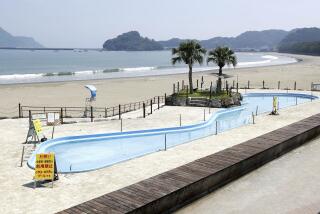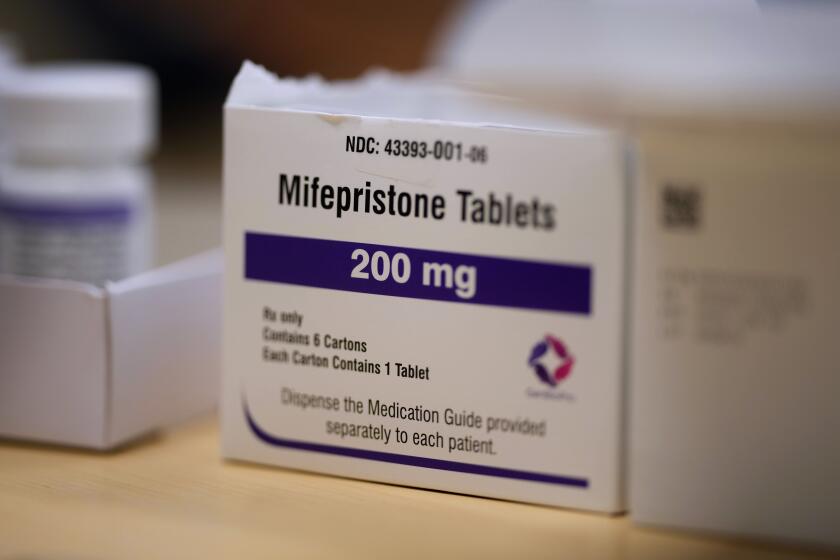IAEA: Japan ‘underestimated,’ so nuclear plant was overwhelmed when disaster struck
- Share via
Reporting from Seoul — Japan did not properly protect its nuclear plants against tsunami threats prior to the March 11 disaster that caused radiation to spew from the Fukushima Daiichi plant, a preliminary report released Wednesday by international nuclear experts concluded.
“The tsunami hazard for several sites was underestimated,” according to a three-page summary released by a United Nations nuclear safety team probing the aftermath of a magnitude 9.0 earthquake that triggered a nearly 50-foot-high wall of water, deluging the plant.
That miscalculation led to meltdowns in three of the facility’s six reactors, which caused the release of harmful radioactive isotopes into the air, soil and seawater. The emergency prompted the evacuation of more than 80,000 residents.
The report by the International Atomic Energy Agency -- compiled by nuclear experts from a dozen nations, including the U.S., France, Russia and China -- blamed the tsunami for causing power outages that quickly caused the disaster to spiral out of control. Inspectors said waves believed to have reached 49 feet in height “overwhelmed” the atomic plant’s defenses.
“In terms of the cause, it is clear: The direct cause was a tsunami, associated with an earthquake of tremendous size,” IAEA fact-finding team leader Michael Weightman, of Britain, told reporters in Tokyo on Wednesday.
Although characterizing Japan’s response to the disaster as “exemplary,” the report called for nuclear plant designers and operators to better coordinate safety preparations at more than a dozen atomic power plants operating nationwide.
Investigators also urged regulatory officials to better monitor the effect that prolonged radiation exposure might have on both the general public and nuclear workers at the crippled plant, located 150 miles north of Tokyo. The full report is scheduled for release later this month at an IAEA conference in Vienna.
The IAEA report summary was released one day after Japan’s health ministry ordered Tokyo Electric Power Co., which operates the stricken plant, to correct deficiencies in protecting facility workers from radiation exposure.
Tepco also acknowledged this week that two workers who were inside the Fukushima plant’s central control room when a hydrogen explosion occurred during the March disaster might have been exposed to an amount of radiation in excess of the government limit of 250 millisieverts for male workers. The utility company says the men are undergoing further tests and show no immediate health issues.
Tepco says the two workers apparently did not take the protective potassium iodide pills required by the company. Potassium iodide is believed to prevent the buildup of radioactive iodine in the thyroid gland. Both workers recorded high iodine levels in their thyroid glands, company officials acknowledge.
The utility has come under fire for failing to fully disclose the extent of radiation exposure faced by plant workers or measures taken to ensure their safety.
Tepco spokesman Ken Matsuda said Wednesday that the utility company was working on the problem. “We will be taking appropriate measures to prevent what we’ve been asked to correct from the government,” he said.
Following an on-site inspection, officials at Japan’s Ministry of Health, Labor and Welfare said the utility company allowed some employees to work without wearing dosimeters, which measure radiation exposure, despite laws that require nuclear workers to wear the devices on the job.
A Tokyo-based electrical engineering company also permitted workers to enter a turbine building flooded with highly radioactive water without wearing protective boots, ministry officials said.
Separate research released Wednesday by Greenpeace points to uncontrolled leaks of extremely radioactive water from the Fukushima Daiichi plant that have caused “severe” radioactive contamination in the surrounding ocean.
The environmental group said research conducted by both Greenpeace and the Japanese government suggested that the radioactive water leakage was “considerably worse and more continuous” than Tepco had acknowledged.
Several trenches and shafts connected to the basements of the stricken reactors were in danger of overflowing and susceptible to damage from storms like the one that battered Japan’s northeast coast this week. In the past, the utility company acknowledged that radioactive water was likely leaking from containment vessels into the basement at several reactors.
“There are likely to be underground leakage pathways that will be very hard to plug, and therefore the only way to stop the ongoing marine contamination is to remove the water from the basements and other structures as quickly as possible,” said Peter Morris, a Greenpeace marine researcher.
Tepco had pumped out the flooded basements, but the utility company has run out of places to store the contaminated water. Water levels inside the basements are again on the rise, he said.
Matsuda said that Tepco was reviewing the claims. “We are in the process of confirming what is being detailed” by Greenpeace, he said.
Tepco officials also acknowledged this week that oil from tanks at the Fukushima Daiichi plant had leaked into the ocean and that the leaks may have been ongoing since the March 11 disaster, according to Japanese media reports.
The IAEA inspectors arrived in Japan last week and conducted on-site inspections at the Fukushima plant. Inspectors praised government efforts to evacuate 80,000 residents living near the plant as “impressive and well organized.”
john.glionna@latimes.com
Tokyo-based freelance writer Yuriko Nagano contributed to this report.
More to Read
Sign up for Essential California
The most important California stories and recommendations in your inbox every morning.
You may occasionally receive promotional content from the Los Angeles Times.














